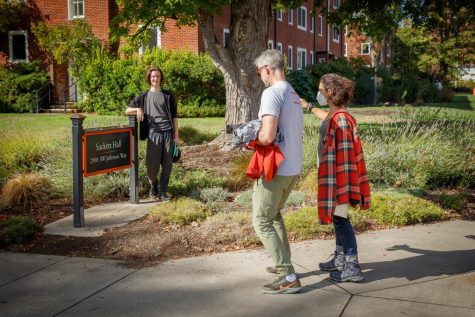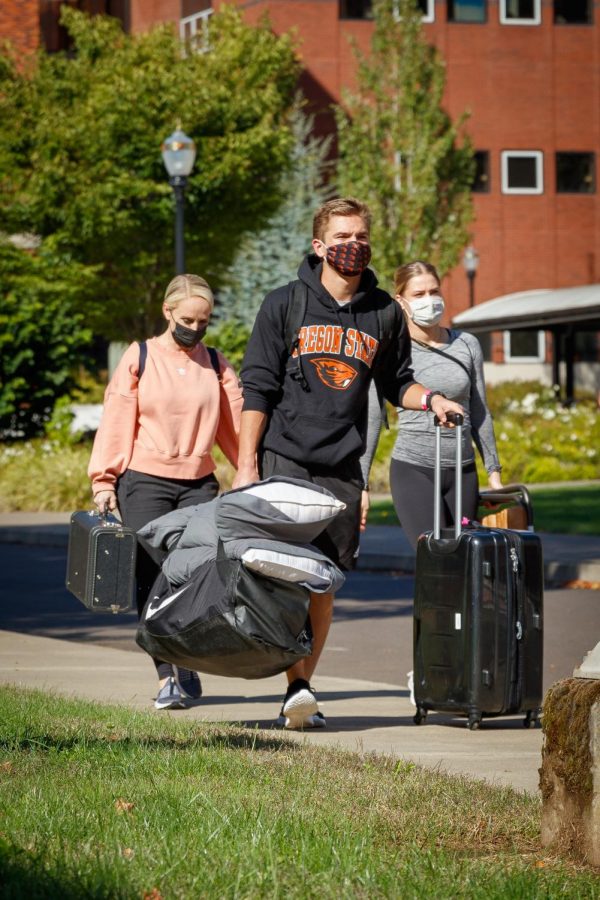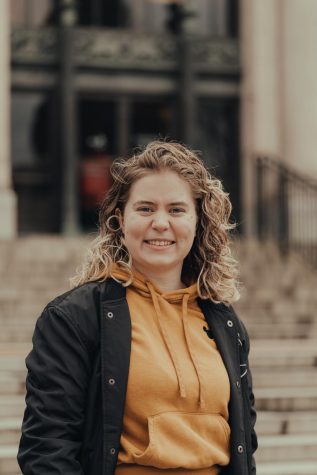Students are back at OSU after a year at home
An incoming student carrying a suitcase and entering a dorm during Oregon State University’s first day of move-in on Sept. 19. The incoming class will be the first group of freshman to experience in-person learning since OSU announced in-person plans for the 2021-22 academic year.
September 27, 2021
Students are now officially back on campus, but in-person class and activity guidelines made in response to COVID-19 will introduce many changes to the Oregon State University community.
Among the many differences students may see fall term is the mandate requiring all students, faculty and staff to wear masks while inside any buildings on the OSU campus.
“Individuals, regardless of their vaccine status, are required to wear a mask or face covering except under a handful of specific circumstances, one of which is when speaking to an audience, such as providing a lecture or instructing a lab,” Steve Clark, vice president of University Relations and Marketing, said.
All other individuals in the audience will be expected to wear their face masks at all times.
To contribute to physical distancing, the university has also tried schedule classes in the most spacious rooms, but Clark said there is currently no six-foot distancing requirement in classrooms.
Another difference pertaining to fall term concerns students who test positive for COVID-19. According to Clark, students and employees will be notified of any university outbreaks of the virus.
“Students who test positive for COVID-19 will need to isolate for 10 days, plus an additional 24 hours after symptoms have improved,” Clark said. “This applies to both vaccinated and unvaccinated students.”
However, when merely exposed to COVID-19, vaccinated and unvaccinated individuals have different requirements they will need to follow.
“Close contact is considered being within six feet of someone [with COVID-19] for a total of 15 minutes or more within a 24-hour period,” Clark said.
Unvaccinated or partially vaccinated individuals who are exposed to COVID-19 will be required to quarantine for 14 days and be tested. Fully vaccinated individuals, when exposed, will not be required to quarantine.
“But they should closely monitor their symptoms and be tested for COVID-19 within three to five days after exposure,” Clark said. “They also should consistently wear a face covering when in public settings for a full 14 days.”
OSU, however, is one of the best-prepared universities in the nation for a safe environment, according to Regan Gurung, the associate vice provost and executive director of the Center for Teaching and Learning, director of the general psychology program and professor of psychology.
“We are doing all [that] science urges and will continue to monitor the situation,” Gurung said. “This may mean changes around the corner if warranted. Be prepared to be flexible.”
Aside from classes, social events and activities will be offered in person too, and they will continue to emphasize public health measures such as mask-wearing.
“The university knows that many students are excited to return to on-site and in-person learning and to be able to attend cultural, social, athletic and community events in person,” Clark said.
Dining halls and dorms on campus have also been updated by University Housing and Dining Services to minimize the risk of COVID-19 spreading.
“The UHDS facilities team has increased air- flow in all our facilities as much as possible, and custodial staff continues to use the appropriate cleaning and disinfectant products to kill the virus if it is on surfaces,” Brian Stroup, director of operations and facilities for UHDS, said.
Stroup added that dining halls are following the appropriate health and safety guidelines as defined by the COVID Safety and Success Policy and local and state health authorities.
Dining halls will continue to operate mostly as normal throughout the fall term and students will be able to eat in dining halls, take their food to go, order express mobile pickup or request robot delivery.
“We will keep the dining halls open as we continue to provide this essential service for students living on campus,” Stroup said. “Any alteration of dining center hours might more likely be caused by staffing challenges.”
With the return to in-person classes, mental health issues such as depression and anxiety as well as stress are also expected to decrease. “Mental health issues have been on the rise for the past few years even before the pandemic,” Gurung said. “Going back to face to face may actually help as it is what most of us are used to… and there may be added motivation and excitement.”
However, this transition may still prove stressful for some students. Transitions always take time, according to Gurung, and can provide more risk to certain students, especially for those without good support systems.
“If your mental health is interfering with your work, share that with your instructor and ask for flexibility,” Gurung said. “The amount of flexibility given will vary from person OSU in- structors have been very supportive and should be seen as a valid resource.”



















































































![Newspaper clipping from February 25, 1970 in the Daily Barometer showing an article written by Bob Allen, past Barometer Editor. This article was written to spotlight both the student body’s lack of participation with student government at the time in conjunction with their class representatives response. [It’s important to note ASOSU was not structured identically to today’s standards, likely having a president on behalf of each class work together as one entity as opposed to one president representing all classes.]](https://dailybaro.orangemedianetwork.com/wp-content/uploads/2025/03/Screenshot-2025-03-12-1.00.42-PM-e1741811160853.png)
























